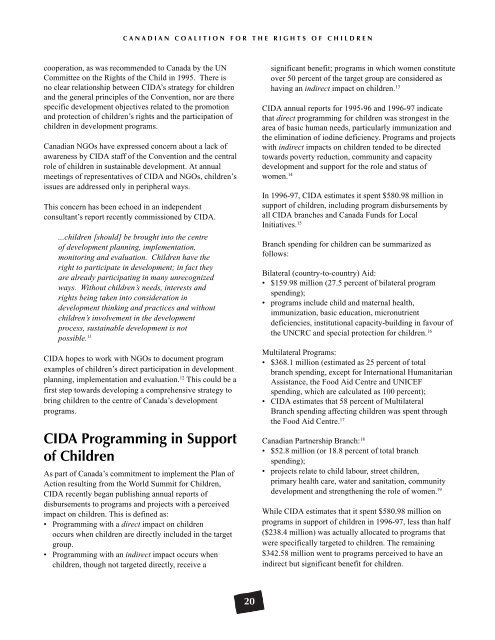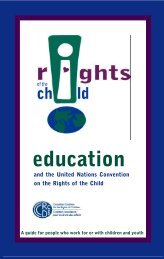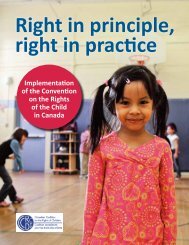Poste - Canadian Coalition for the Rights of Children
Poste - Canadian Coalition for the Rights of Children
Poste - Canadian Coalition for the Rights of Children
You also want an ePaper? Increase the reach of your titles
YUMPU automatically turns print PDFs into web optimized ePapers that Google loves.
C A N A D I A N C O A L I T I O N F O R T H E R I G H T S O F C H I L D R E N<br />
cooperation, as was recommended to Canada by <strong>the</strong> UN<br />
Committee on <strong>the</strong> <strong>Rights</strong> <strong>of</strong> <strong>the</strong> Child in 1995. There is<br />
no clear relationship between CIDA’s strategy <strong>for</strong> children<br />
and <strong>the</strong> general principles <strong>of</strong> <strong>the</strong> Convention, nor are <strong>the</strong>re<br />
specific development objectives related to <strong>the</strong> promotion<br />
and protection <strong>of</strong> children’s rights and <strong>the</strong> participation <strong>of</strong><br />
children in development programs.<br />
<strong>Canadian</strong> NGOs have expressed concern about a lack <strong>of</strong><br />
awareness by CIDA staff <strong>of</strong> <strong>the</strong> Convention and <strong>the</strong> central<br />
role <strong>of</strong> children in sustainable development. At annual<br />
meetings <strong>of</strong> representatives <strong>of</strong> CIDA and NGOs, children’s<br />
issues are addressed only in peripheral ways.<br />
This concern has been echoed in an independent<br />
consultant’s report recently commissioned by CIDA.<br />
...children [should] be brought into <strong>the</strong> centre<br />
<strong>of</strong> development planning, implementation,<br />
monitoring and evaluation. <strong>Children</strong> have <strong>the</strong><br />
right to participate in development; in fact <strong>the</strong>y<br />
are already participating in many unrecognized<br />
ways. Without children’s needs, interests and<br />
rights being taken into consideration in<br />
development thinking and practices and without<br />
children’s involvement in <strong>the</strong> development<br />
process, sustainable development is not<br />
possible. 11<br />
CIDA hopes to work with NGOs to document program<br />
examples <strong>of</strong> children’s direct participation in development<br />
planning, implementation and evaluation. 12 This could be a<br />
first step towards developing a comprehensive strategy to<br />
bring children to <strong>the</strong> centre <strong>of</strong> Canada’s development<br />
programs.<br />
CIDA Programming in Support<br />
<strong>of</strong> <strong>Children</strong><br />
As part <strong>of</strong> Canada’s commitment to implement <strong>the</strong> Plan <strong>of</strong><br />
Action resulting from <strong>the</strong> World Summit <strong>for</strong> <strong>Children</strong>,<br />
CIDA recently began publishing annual reports <strong>of</strong><br />
disbursements to programs and projects with a perceived<br />
impact on children. This is defined as:<br />
• Programming with a direct impact on children<br />
occurs when children are directly included in <strong>the</strong> target<br />
group.<br />
• Programming with an indirect impact occurs when<br />
children, though not targeted directly, receive a<br />
20<br />
significant benefit; programs in which women constitute<br />
over 50 percent <strong>of</strong> <strong>the</strong> target group are considered as<br />
having an indirect impact on children. 13<br />
CIDA annual reports <strong>for</strong> 1995-96 and 1996-97 indicate<br />
that direct programming <strong>for</strong> children was strongest in <strong>the</strong><br />
area <strong>of</strong> basic human needs, particularly immunization and<br />
<strong>the</strong> elimination <strong>of</strong> iodine deficiency. Programs and projects<br />
with indirect impacts on children tended to be directed<br />
towards poverty reduction, community and capacity<br />
development and support <strong>for</strong> <strong>the</strong> role and status <strong>of</strong><br />
women. 14<br />
In 1996-97, CIDA estimates it spent $580.98 million in<br />
support <strong>of</strong> children, including program disbursements by<br />
all CIDA branches and Canada Funds <strong>for</strong> Local<br />
Initiatives. 15<br />
Branch spending <strong>for</strong> children can be summarized as<br />
follows:<br />
Bilateral (country-to-country) Aid:<br />
• $159.98 million (27.5 percent <strong>of</strong> bilateral program<br />
spending);<br />
• programs include child and maternal health,<br />
immunization, basic education, micronutrient<br />
deficiencies, institutional capacity-building in favour <strong>of</strong><br />
<strong>the</strong> UNCRC and special protection <strong>for</strong> children. 16<br />
Multilateral Programs:<br />
• $368.1 million (estimated as 25 percent <strong>of</strong> total<br />
branch spending, except <strong>for</strong> International Humanitarian<br />
Assistance, <strong>the</strong> Food Aid Centre and UNICEF<br />
spending, which are calculated as 100 percent);<br />
• CIDA estimates that 58 percent <strong>of</strong> Multilateral<br />
Branch spending affecting children was spent through<br />
<strong>the</strong> Food Aid Centre. 17<br />
<strong>Canadian</strong> Partnership Branch: 18<br />
• $52.8 million (or 18.8 percent <strong>of</strong> total branch<br />
spending);<br />
• projects relate to child labour, street children,<br />
primary health care, water and sanitation, community<br />
development and streng<strong>the</strong>ning <strong>the</strong> role <strong>of</strong> women. 19<br />
While CIDA estimates that it spent $580.98 million on<br />
programs in support <strong>of</strong> children in 1996-97, less than half<br />
($238.4 million) was actually allocated to programs that<br />
were specifically targeted to children. The remaining<br />
$342.58 million went to programs perceived to have an<br />
indirect but significant benefit <strong>for</strong> children.




